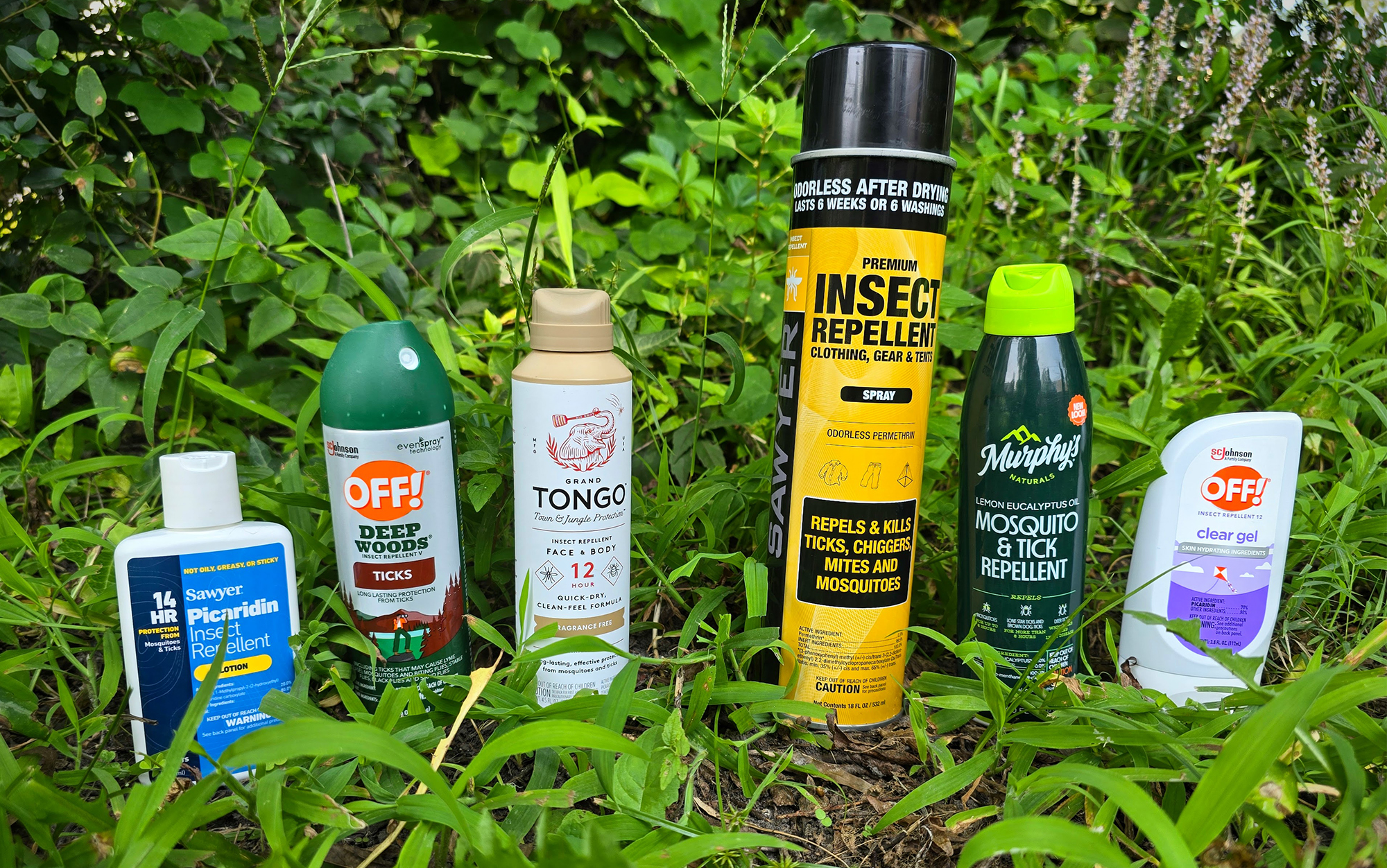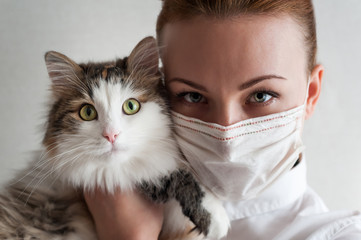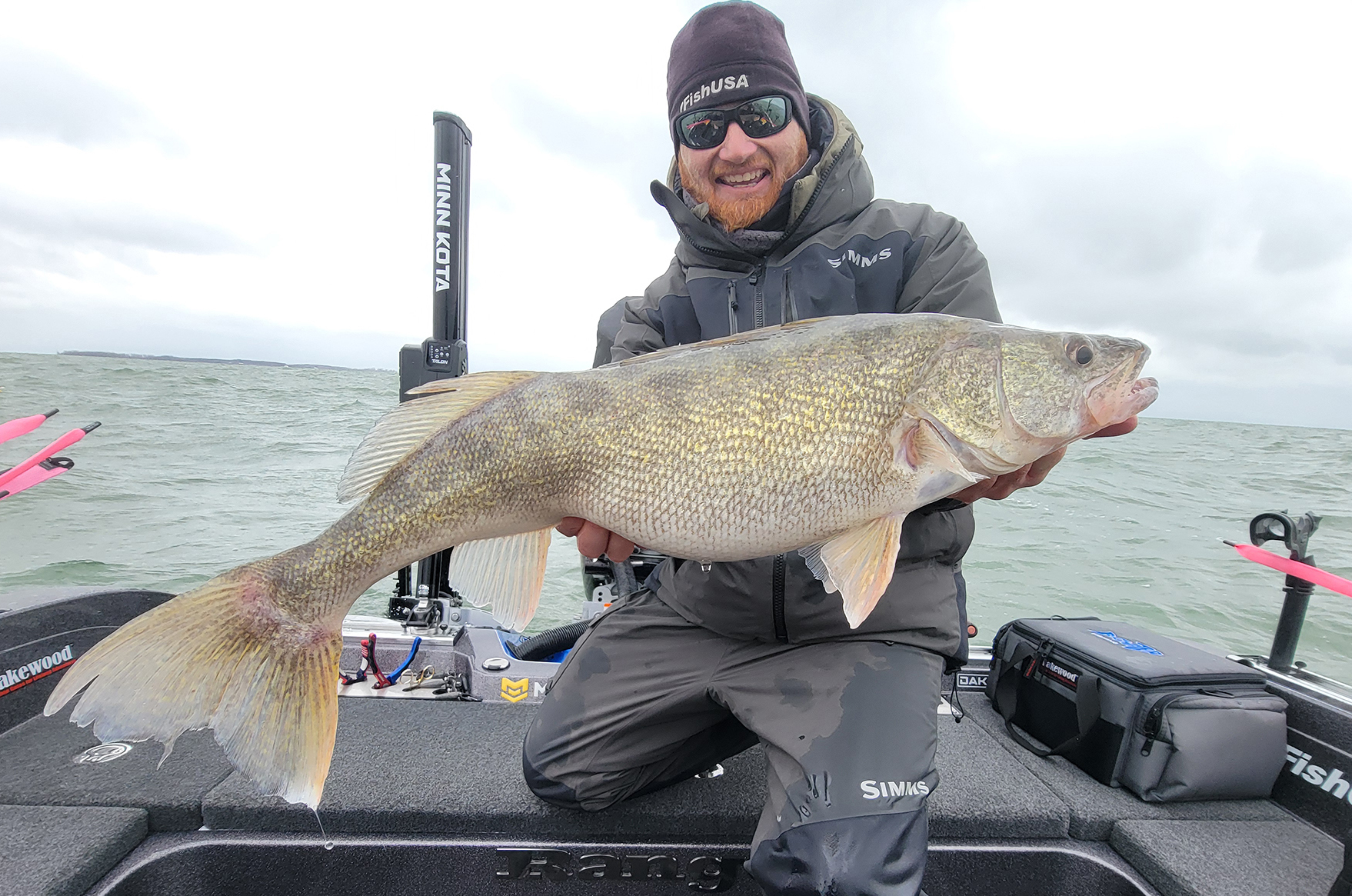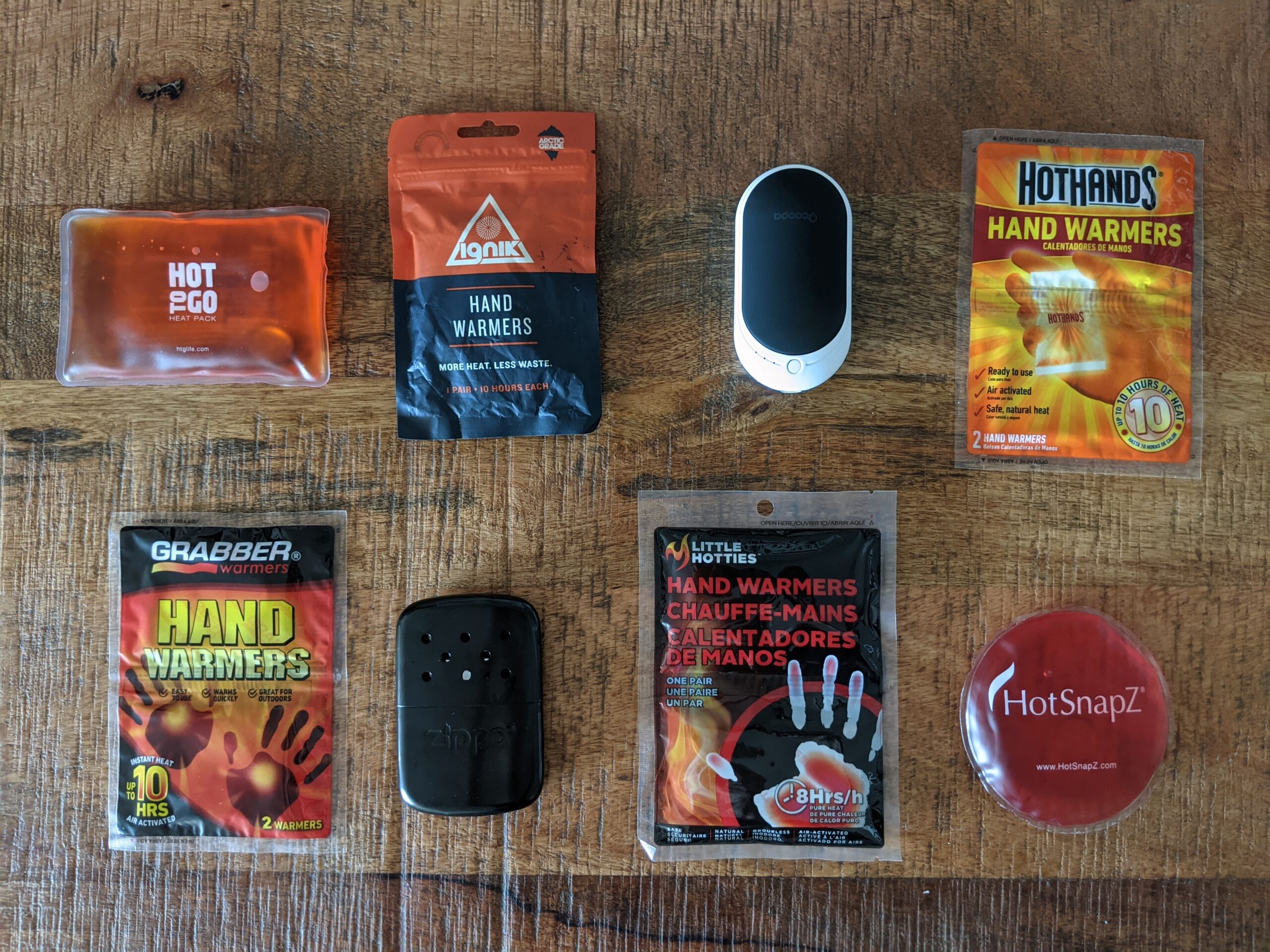Best Tick Repellents of 2024

We may earn revenue from the products available on this page and participate in affiliate programs. Learn More ›
If you’ve spent more than half a minute in the woods in warmer weather, you are well aware that ticks suck. These multi-legged parasitic arachnids literally suck the blood of their chosen hosts, leaving behind itchy bites and sometimes dangerous diseases such as Lyme disease, Rocky Mountain Spotted Fever, anaplasmosis, and alpha-gal syndrome (AGS), which can trigger an allergy to red meat. Ticks also figuratively suck because they’re just plain gross.
According to the Centers for Disease Control, avoiding wooded and bushy areas is the best way to prevent tick bites. Unfortunately, this isn’t feasible for sportsmen and women since those areas are the exact places game animals call home. If you want to avoid creepy-crawly ticks and still enjoy the great outdoors, you’ll need to use an effective tick repellent.
How I Tested the Best Tick Repellents
Modern tick repellent comes in a wide variety of forms and formulas, from old-school chemical DEET to natural non-toxic essential oils. You can even take advantage of odor-free insect-repellent clothing. But does any of it work? I braved the tick-infested woods to put the best tick-repellent sprays, creams, and clothing to the test.
Does it Repel Ticks?
Fancy packaging and manufacturer’s claims mean nothing if the products don’t deter ticks. I applied each spray product to strips of a dirty white cotton t-shirt. Before application, the shirt had been worn for an afternoon of yard work in the North Carolina summer to ensure it had plenty of that yummy human smell that ticks find appealing. I then laid each strip, including a non-treated control strip, in a known tick hotspot, sat back, and waited for the buggers to arrive. Ticks seemed to give most of the treated strips a wide berth, but at least two seed ticks waltzed right over the control strip, although they kept moving when they realized there wasn’t a meal nearby.
I also applied each of our test repellents according to package directions and headed into tick country to check trail cameras and clear shooting lanes in the August heat.
How Does it Feel on Your Skin?
Some bug sprays can leave you feeling like a slippery, slimy, greased hog. This may be great for fighting off ticks, but it can really detract from your outdoor experience, particularly in hot, sticky climates. I evaluated how each product felt against the skin both before and after working up a sweat.
How Bad Does it Stink?
Time and testing have both proven that DEET-based repellents are incredibly effective for keeping ticks at bay. However, the stuff reeks. While it may be a sound option for camping, hiking, fishing, and even dove or rabbit hunting, DEET-based insect repellents just aren’t practical for hunters trying to slip past the keen noses of ungulates during bow season. So while I acknowledge that smell is a key way many tick repellents work, the odor can negatively impact outdoor experiences.
It’s also no secret that people don’t enjoy sharing a truck cab or hunting cabin with a buddy drenched in noxious bug spray. That’s why I scored each repellent on how well I could pick up the odor. I used a five-point scale, with one being the faintest and five being the stinkiest.
How Easy is it to Use?
I also evaluated how easy each repellent was to apply. Easy spray-and-go applications ranked high in this category.
Best Tick Repellents: Reviews & Recommendations
Best Overall: Grand Tongo Fragrance-Free Insect Repellent
See It
Key Features
- Active Ingredient: Picaridin
- Odor Score: 1
- 4.5 fluid ounces
- Price: $15
Pros
- Dries fast
- Lasts for up to 12 hours
- Disappears on your skin
- Safe to use on your face
Cons
Grand Tongo insect repellent is my go-to bug spray for extended camping trips. The spray mist goes on smoothly and evenly. It’s also super lightweight and dries so fast it was easy to forget I had even put it on. The fragrance-free formula leaves no residual odor on your skin or clothing. This is a major bonus when you’re sliding into a sleeping bag at the end of the day without a proper shower.
Grand Tongo’s fragrance-free formula has a faint smell when applying it, but the scent disappears within seconds. The brand also offers a mildly fragranced green tea and mint and a pleasant-smelling citrus and sandalwood variety if you’re looking to add some pleasant aromas to your backyard or campsite.
The formula provides 12 hours of protection against ticks and mosquitoes and eight hours of relief from gnats, chiggers, biting midges, and flies. It was honestly difficult to find anything to criticize, but the 4-ounce bottle doesn’t seem to last as long as other repellents in similarly sized containers.
Best Budget: OFF! Deep Woods Tick
See It
Key Features
- Active Ingredient: 25 percent DEET
- Odor Score: 5
- 6 fluid ounces
- Price: $7
Pros
- Easy to apply
- Provides all-over coverage
- Affordable
Cons
- It reeks
- Can cause negative reactions in some people
When it comes to fending off ticks and mosquitoes, OFF! is the OG. Does it leave you feeling sticky and greasy? Yes. Does it make you smell like a noxious chemical cocktail? Yes. Does it ward off a whole host of biting bugs, including ticks, for hours? You’re darn skippy, it does.
We have definitely come a long way in taming the tell-tale stench of chemical insect repellents, but this one is old-school. And since so many of my formative outdoor memories are drenched in DEET, the smell of Deep Woods Off! feels deeply nostalgic.
Best Lotion: Sawyer Picaridin Insect Repellent Lotion
See It
Key Features
- Active Ingredient: Picaridin
- Odor Score: 2
- 4 fluid ounces
- Price: $12
Pros
- Good for precise application in sensitive areas around face and neck
- Lasts up to 14 hours
Cons
- Whole-body application isn’t practical
Sawyer’s Picaridin Lotion totally busts the concept that insect-repellent has to be sprayed on in a toxic fog to be effective. You apply this one just like you slather on sunscreen at the lake. It even has a similar consistency and feel to typical SPF 30. It goes on without any fumes. The lotion has only a mild citrus odor that practically disappears once it dries on your skin. In addition to effectively repelling ticks and mosquitoes for up to 14 hours, Sawyer Picaridin Lotion also keeps chiggers, biting flies, and gnats at bay for up to six hours.
Because this is a lotion, it doesn’t work well as a whole-body treatment. However, it is perfect for filling the gaps in most tick-repellent strategies. Since it is easier (and arguably safer) to apply to areas around your face, ears, neck, and hands, this product functions well as a supplement to clothing treatments or spray-on repellents.
Best for Skin: OFF! Clean Feel Insect Repellent Clear Gel
See It
Key Features
- Active Ingredient: Picaridin
- Odor Score: 3
- 6 fluid ounces
- Price: $10
Pros
- Easy to apply
- Contains skin softening ingredients
Cons
- Impossible to treat entire body
I never thought I would enjoy applying any insect-repellent, but OFF! Clean Feel Gel totally changed my mind. This clear gel product is easy to use and goes on evenly without any greasy residue. It also made my skin feel immediately softer.
While this is technically a fragrance-free product, it does have a detectable smell. I scored it as a 3, although the pungency drops to a 2 after it goes on. The scent becomes practically undetectable after about 15 minutes, so it could work for deer hunters. However, the gel just isn’t practical for all-over applications. It works better as a supplemental option for hands, ankles, and around the ears and neck.
Best for Treating Clothing: Sawyer Premium Insect Repellent
See It
Key Features
- Active Ingredient: Permethrin
- Odor Score: 1
- 24 fluid ounces
- Available as a pump or aerosol spray
- Price: $13
Pros
- Unscented
- Lasts up to six weeks
Cons
- Must be applied in advance and allowed to dry completely
- Can’t be used on skin
Sawyer’s permethrin spray differs from standard bug spray because you can’t just spray yourself down and head outdoors. Permethrin must be applied to clothing in advance and allowed to dry for at least two hours before you suit up. It also can’t be applied directly to the skin, which leaves places like your face, neck, and hands unprotected.
Despite the drawbacks, there are few things ticks hate more than permethrin. Sawyer claims that a single spray treatment lasts six weeks or six washes, and my experience supports the claim. In hunting seasons past, I’ve treated my hunting pants, shirt, and hunting boots the night before the turkey season opener and remained mostly tick-free for the entire season. Sawyer Permethrin Spray also works against mosquitoes, chiggers, and fleas and leaves behind no detectable smell.
Best Natural: Murphy’s Naturals Lemon Eucalyptus Oil Mosquito and Tick Repellent Mist
See It
Key Features
- Active Ingredient: Oil of Lemon Eucalyptus
- Odor Score: 4
- 6 fluid ounces
- Also available in a pump spray
- Price: $17
Pros
- Made from botanical ingredients
- Won’t stain or degrade clothing or gear
Cons
- Strong lemony smell
- Needs frequent reapplication
- Leaves a slightly sticky residue on skin
Murphy’s Naturals is a solid option if you want to minimize chemical exposure while minimizing tick bites. This product uses oil from the lemon eucalyptus plant. The brand sources the oil using a steam distillation process that minimizes waste and uses a closed-loop recycled water cycle. In other words, it’s as good for the environment as it is for your body. The company claims their formula repels deer ticks for up to four hours and lone star and dog ticks for more than eight, which means you might need to reapply if you have dark-to-dark plans outside.
This mist was the easiest-spraying option in the test bunch and provided the most even coverage, although it has a slightly sticky feel. It has a pungent lemon-eucalyptus smell, but it isn’t unpleasant or chemically. However, it may not be the smell you’re going for if you’re trying to remain incognito in the woods.
Best Tick-Repellent Hunting Clothing: Sitka Equinox Guard
See It
Key Features
- Active Ingredient: Permethrin
- Odor Score: 1
- UPF 50+ sun protection
- Breathable fabric
- Scent-free
- Price: $249 (pants), $149 (hoodie), $50 (gloves)
Pros
- Lasts for 70 washes
- Lightweight
- Durable construction
Cons
- Expensive
- Not available in women’s sizes
If you need camo gear for spring turkeys or early archery season, Sitka Equinox Guard offers excellent concealment with built-in insect repellent. The system incorporates Insect Shield technology, which binds a permethrin-based formula to the garment’s threads. The formula will not rub off on your skin and lasts up to 70 trips through the washing machine.
Sitka also added Polygiene odor control technology to their Equinox Guard line. This state-of-the-art tech uses silver salt and silica in the fabric to neutralize odors caused by sweat, which means you won’t have to wash your gear unless it’s bloody or muddy. Less frequent washing means it will take multiple seasons to reach that 70-load limit, even if you’re used to hunting hard.
To get the best tick protection, you’ll need the entire system, which includes pants, a lightweight hoodie, and gloves. The biggest drawback to this gear is the price. A whole system will set you back about $425. However, the repellent should last nearly forever, so you’ll save the cost of permethrin bottles over time.
My son wore this system on a mother/son turkey hunt this spring for a side-by-side test against Forloh’s Insect Shield clothing. Both systems performed equally well against ticks. Picking a winner between the two felt a lot like someone asking me, as a mother, to pick my favorite child. In the end, this isn’t toddler t-ball where everyone comes out a winner. Sitka won out simply because it feels sturdier in the woods, the hoody has a built-in face mask, and the pants have more pockets. And honestly, you can never have too many pockets.
Best Hunting Clothing Runner-Up: Forloh Insect Shield
See It
Key Features
- Active Ingredient: Permethrin
- Hyper-wicking and fast-drying
- Odor-control tech
- UPF 1000+
- Price: $129 (pants), $109 (hooded long-sleeve shirt)
Pros
- Lasts for 70 washes
- Relatively affordable
- Extra comfortable
Cons
- Minimal pockets
- Could be more durable
I fell in love with Forloh’s Insect Shield system during the 2024 North Carolina spring turkey season. It was the first season I made it through without bringing home a single tick or chigger. The technology definitely works.
Not only does this system include Insect Shield, but it also hosts a ton of other hunter-friendly tech. This clothing line-up features Brrr Pro cooling minerals for hyper-wicking and fast-drying fibers. It also has built-in UV protection and Polygiene tech that eliminates both foreign odors and odors caused by sweat-loving bacteria.
The system consists of a hooded long-sleeve shirt and lightweight pants, both of which are designed and made entirely in the USA. They are super comfortable, and it almost felt like I was walking into the woods in my pajamas. Despite their silky, lightweight feel, they are surprisingly durable, although they really work better as a base layer.
How to Choose the Best Tick Repellents
The best defense against ticks is to use a good offense, and there are a variety of chemical compounds and natural ingredients that ticks find offensive. Here is a breakdown of how the most popular tick repellents work.
DEET
DEET (which somehow stands for N,N-diethyl-meta-toluamide) is the oldest and one of the most effective insect-repellent compounds in use today. It is designed for direct use on the skin and makes it harder for ticks to smell you and identify you as a walking buffet. Unfortunately, DEET is inherently smelly and can leave a greasy residue on your skin and clothing that does not easily dissolve in water.
DEET-containing products come in a variety of forms, including liquids, lotions, sprays, towelettes, and roll-ons. Although DEET tick repellents are convenient and effective, they can have side effects. Some people experience skin irritation or develop bad rashes. It can also cause nausea, vomiting, and upset stomach if swallowed. Overexposure can trigger nasty side effects, including blisters, aggressive behavior, and seizures.
Permethrin
Permethrin is a synthetic compound similar to a natural compound found in chrysanthemums. It takes care of ticks by overstimulating their nervous system, resulting in paralysis and eventually death, which means this isn’t technically a “tick repellent”.” It’s an insecticide.
Unlike most repellents, permethrin isn’t something you want to spray on your skin. Instead, you treat your clothing and gear with it and let them dry thoroughly before wearing them. You can also buy clothing made from permethrin-infused fabric.
Spray treatments of permethrin generally last for about six weeks. Permethrin fabric will last up to 70 washes if you follow the manufacturer’s laundering instructions.
Permethrin is an endocrine-disrupting compound, so you don’t want to inhale or absorb through your skin. However, if you follow application instructions, exposure is limited, and chances of side effects are minimal. Reported side effects include headache, dizziness, fatigue, muscle weakness, nausea, and vomiting.
Picaridin
Developed in the 1980s, picaridin is much younger than DEET but works similarly. It doesn’t kill insects but seems to block ticks and mosquitoes from registering you as a potential meal. Studies suggest that picaridin is slightly more effective than DEET at repelling mosquitoes and equally effective at deterring ticks.
Unlike DEET, picaridin is odorless and non-greasy and rarely causes skin irritation.
Oil of Lemon Eucalyptus
Oil of Lemon Eucalyptus (OLE) is a synthetic concentration of para-methan-3,8-diol (PMD for short), which is a natural compound found in the lemon eucalyptus plant. OLE differs from lemon eucalyptus essential oil, which has a much lower concentration of PMD and lacks the same repellent qualities.
Research suggests that OLE affects tick attachment and feeding, and it may be more effective than DEET or picaridin in repelling pesky parasites. It also has a lemony scent that some people find pleasing. OLE products can cause minor skin irritation in some individuals.
Essential Oils
Several essential oils have been scientifically proven to repel ticks, including creeping thyme, citronella, clove bud, and red thyme. The drawback to using tick-repellent products that contain essential oils is that few studies have been conducted on their safety. The Environmental Protection Agency has approved no essential oils for use against ticks.
FAQs
According to the Global Lyme Alliance, repellents that contain DEET, Permethrin, Picaridin, or Oil of Lemon Eucalyptus are most effective for preventing tick bites.
Creeping thyme, citronella, clove bud, and red thyme essential oils have proven effective at repelling ticks in laboratory studies. However, the EPA has not approved essential oils for use against ticks. However, Murphy’s Naturals Lemon Eucalyptus Oil Mosquito and Tick Repellent Mist is made with plant-derived ingredients that are gentler on the skin than many chemical repellents.
According to the CDC, the best way to avoid ticks is to reduce tick exposure by avoiding brushy or wooded areas, walking in the center of trails, treating your clothing and gear with products containing 0.5 percent permethrin, and using EPA-approved insect repellents.
Final Thoughts on the Best Tick Repellents
Hunting, fishing, camping, and everything else outdoors is tons more fun without worrying about ticks. While there are plenty of effective options to choose from, the key to finding the best tick repellent is choosing one that not only keeps the creepy-crawlies away but also suits your outdoor needs and lifestyle.
Read the full article here







